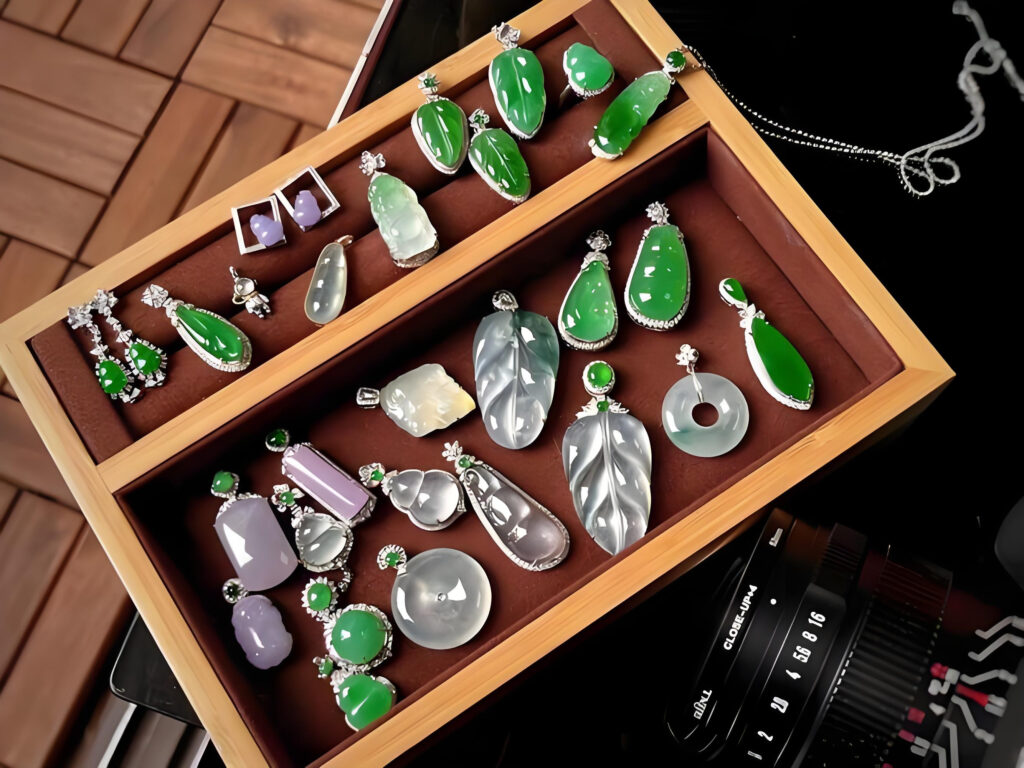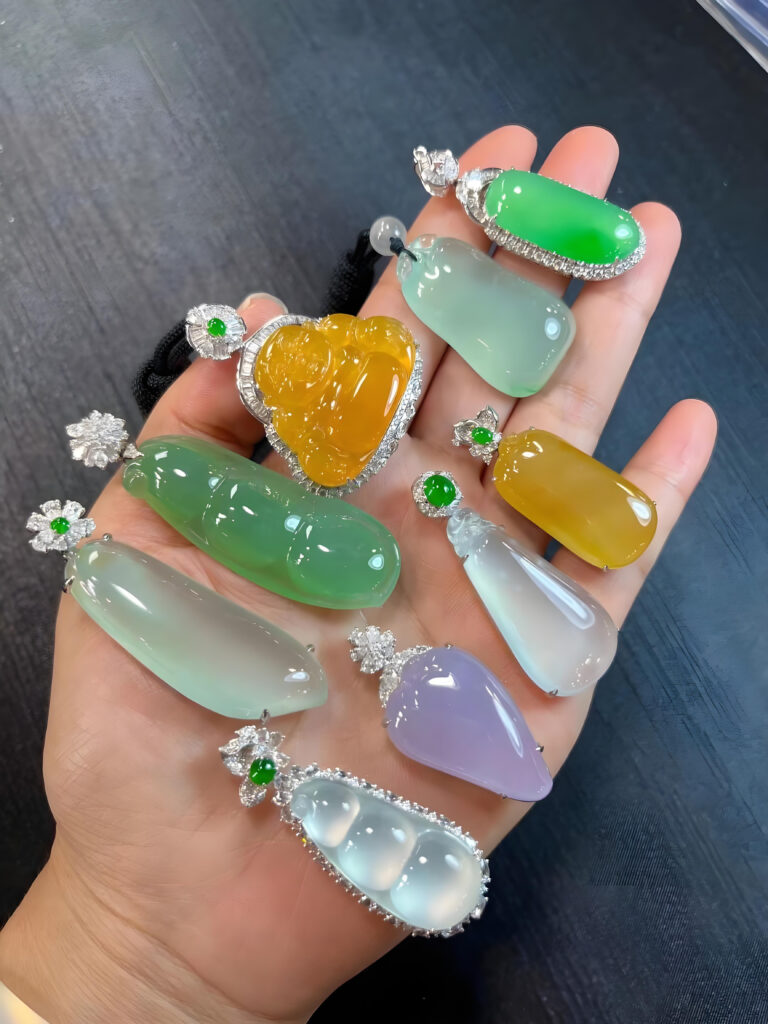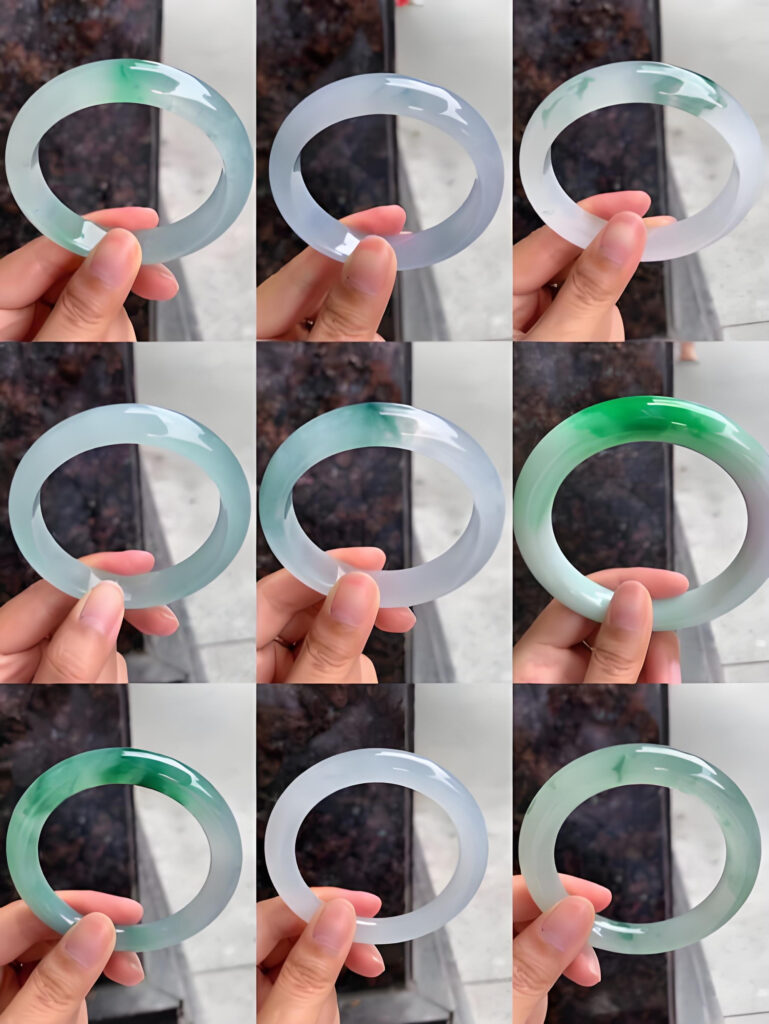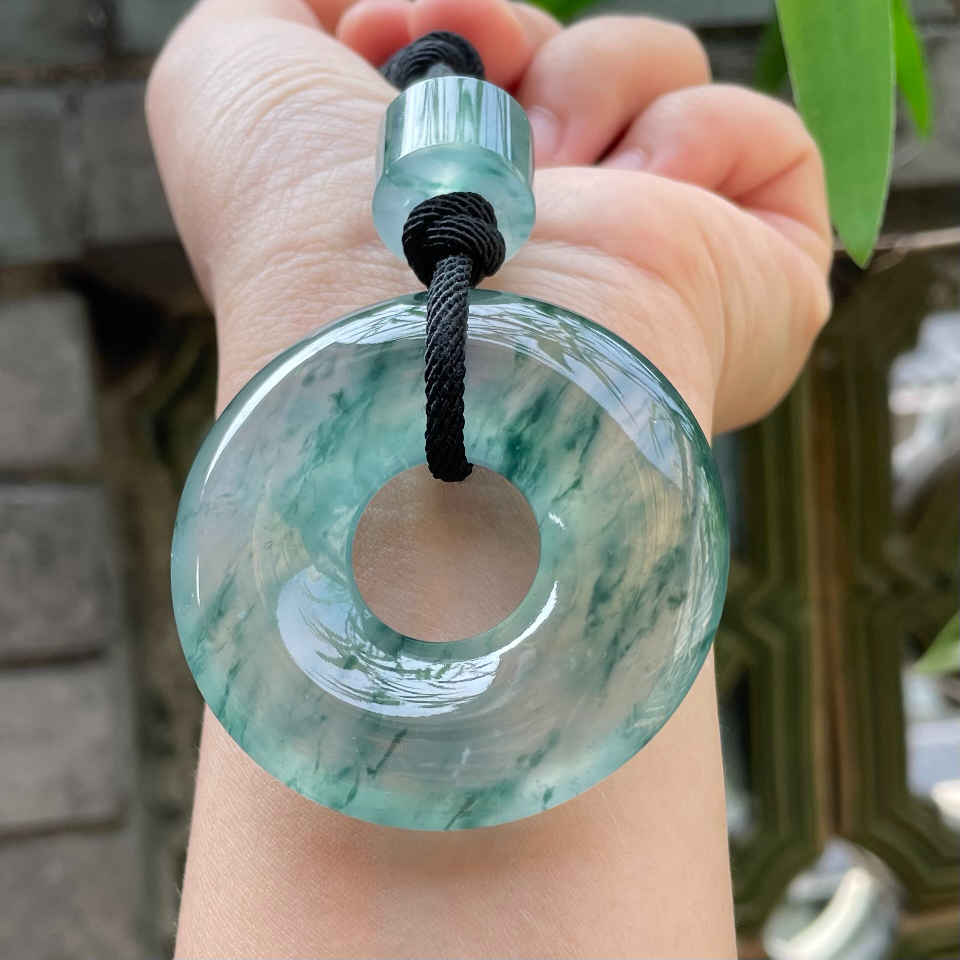Table of Contents

1. Introduction: The Allure of Jade’s Color Spectrum
When people ask, “what color is jade?” the answer is far from simple. Jade is renowned not only for its durability and smooth texture but also for its stunning range of colors. While many immediately associate jade with a rich green hue, the truth is that jade exists in an incredible spectrum—from translucent whites to deep blacks and even soft lavenders.
This variety of colors contributes to jade’s mystique and universal appeal. Each color carries its own cultural symbolism and energetic properties, making jade a gemstone deeply embedded in history, spirituality, and art. Whether used in jewelry, sculptures, or talismans, jade’s color palette reflects both natural beauty and profound meaning.
Understanding the colors of jade helps collectors, enthusiasts, and buyers appreciate the stone’s unique characteristics. As we explore what color jade can be, you’ll discover how the interplay of minerals and geological processes create this diverse and captivating gemstone.
2. Understanding Jade: Nephrite vs. Jadeite
Before diving deeper into the question, “what color is jade?”, it’s essential to understand that jade actually refers to two distinct minerals: nephrite and jadeite. Both are highly valued for their toughness and beauty, but they differ in composition, origin, and color range.
- Nephrite is a calcium magnesium iron silicate, traditionally found in regions like China, New Zealand, and Russia. Its colors tend to be more subdued, typically ranging from creamy white and various greens to browns and blacks. Nephrite jade is often described as having a smooth, waxy texture and is prized for its durability.
- Jadeite, on the other hand, is a sodium aluminum silicate mineral primarily sourced from Myanmar (Burma). Jadeite boasts a broader and more vibrant color spectrum, including the famous imperial green jade, lavender, white, yellow, and even rare reds and blues. Due to its vivid colors and translucency, jadeite is generally considered more valuable, especially in fine jewelry.
Understanding the differences between nephrite and jadeite is crucial when considering the question “what color is jade?” because the mineral type directly influences the available colors, translucency, and overall quality of the gemstone.

3. What Color Is Jade? The Classic Green and Beyond
When pondering the question, “what color is jade?”, many people first think of the iconic green shades. However, jade’s true beauty lies in its vast color spectrum, which extends well beyond green. Both nephrite and jadeite minerals present a wide range of hues, each with unique characteristics, meanings, and values. To better understand what color is jade, let’s explore the most popular and rare colors of jade that captivate collectors and enthusiasts worldwide.
3.1 Imperial Green
Imperial green is perhaps the most famous and coveted color of jadeite. This vibrant, emerald-like green is highly translucent and intense, often referred to as the “king” of jade colors. Its rich hue symbolizes purity, growth, and prosperity. When people ask “what color is jade?”, imperial green frequently tops the list as the epitome of jade’s allure and value. Due to its rarity and desirability, imperial green jade commands premium prices in the jewelry market and is a prime example of sought-after jade color.
3.2 Apple Green
Apple green jade offers a lighter, fresher green tone than imperial green, often described as bright and lively. This color is associated with youthfulness, renewal, and vitality. Apple green jade is a popular choice for those wondering what color is jade that is more subtle yet still vibrant. It is widely used in necklaces, bracelets, and pendants, favored for its cheerful and energetic vibe.
3.3 Moss Green
Moss green jade resembles the deep, earthy colors of forest moss, often characterized by a blend of green shades with black or brown inclusions. This color reflects nature’s grounding energy and is prized for its organic, natural look. Moss green jade is especially popular in traditional carvings and spiritual amulets. For those interested in what color is jade with more natural, muted tones, moss green offers a beautiful option that brings balance and healing.
3.4 Ice or White Jade
Ice jade, also known as white jade, stands out with its translucent, almost glass-like appearance. This color often shows a pure, milky white tone with a subtle sparkle. Ice jade is valued for its serene, calming qualities and is linked to purity and spiritual clarity. When exploring what color is jade, white or ice jade is often highlighted for its understated elegance and peaceful aesthetic.
3.5 Yellow Jade
Yellow jade captivates with its warm, golden hues ranging from pale buttery shades to rich amber tones. This color symbolizes happiness, wisdom, and optimism. Yellow jade is often associated with the earth element and is believed to bring stability and good fortune. If you are asking “what color is jade” that conveys warmth and positive energy, yellow jade is a popular and meaningful choice.
3.6 Lavender Jade
Lavender jade is a beautiful and rare variation, featuring soft purple and lilac tones. This gentle hue symbolizes spiritual awareness, calm, and creativity. Lavender jade is highly prized in both Chinese and Western markets due to its unique color and rarity. For those curious about what color is jade beyond the greens and whites, lavender jade offers a refined, meditative option.
3.7 Black Jade
Black jade, which can be either nephrite or jadeite, offers a striking contrast to more traditional jade colors. Its deep, opaque black tone is often polished to a high shine, giving it a mysterious and powerful aura. Black jade is believed to provide protection, absorb negative energy, and promote inner strength. Those asking what color is jade that conveys power and mystery often find black jade a compelling choice.
3.8 Red and Orange Jade
Though less common, red and orange jade display vibrant fiery hues ranging from bright scarlet to warm tangerine. These colors are linked to passion, vitality, and creativity. Red and orange jade pieces are often worn to energize the spirit and boost motivation. Their rarity adds to their appeal among collectors seeking distinctive, colorful stones when exploring what color is jade beyond the usual spectrum.
3.9 Blue Jade
Blue jade is a rare and captivating color that ranges from pale sky blue to deeper, more saturated shades. This color is associated with calmness, communication, and tranquility. Blue jade is prized for its soothing energy and unique appearance, making it a sought-after choice for jewelry and spiritual tools. Its scarcity often makes blue jade more valuable and desirable for those wondering what color is jade with tranquil and calming tones.
Summary
So, what color is jade? The answer is a vibrant spectrum that includes everything from the classic greens to unique yellows, lavenders, blacks, and even blues. Each color holds its own symbolism, cultural significance, and appeal, making jade a truly versatile and meaningful gemstone.
Understanding these diverse jade colors empowers buyers and enthusiasts to appreciate the depth and richness of this ancient stone beyond the common green, enriching their connection with jade’s beauty and heritage.
4. What Determines Jade Color? Natural Factors and Treatments
When asking, “what color is jade?”, it’s important to understand that jade’s beautiful and diverse colors are the result of complex natural processes as well as human enhancements. The question “what color is jade?” cannot be fully answered without exploring how its mineral composition, trace elements, geological formation, and treatments all contribute to the colors we see in jade stones.
Mineral Composition and Trace Elements
Jade mainly consists of two minerals: nephrite and jadeite. Each mineral has distinct chemical components, which directly influence what color is jade in a given specimen:
- Nephrite is a calcium magnesium iron silicate, generally showing colors ranging from creamy white to various shades of green, brown, and black. These natural hues are a reflection of its mineral makeup and environmental formation.
- Jadeite is a sodium aluminum silicate that exhibits a wider color range, including vibrant greens, lavender, white, yellow, red, and blue hues. The variety of colors found in jadeite answers many inquiries into what color is jade and why jade can look so different from piece to piece.
The presence and concentration of trace elements are key factors in determining what color is jade:
- Iron can produce green, yellow, and brown tones in jade stones, contributing to some of the most common jade colors.
- Chromium is responsible for the vivid emerald-green color found in highly prized imperial jade, often cited as the ultimate answer to what color is jade for collectors.
- Manganese creates purple and lavender shades, explaining the existence of rare lavender jade varieties.
- Titanium and other elements contribute to blue and black colors, adding further diversity to the jade color spectrum.
Geological Formation
The natural geological conditions under which jade forms — including pressure, temperature, and the mineral content of its environment — play a crucial role in shaping what color is jade. These factors affect the jade’s color saturation, translucency, and unique patterns such as veins or mottling that make each jade piece distinctive.
Treatments and Enhancements
Because jade is highly valued and sought after, many jade stones undergo treatments to enhance or alter their color. Knowing about these treatments is essential when asking “what color is jade?”, especially to distinguish natural jade from treated or synthetic stones:
- Dyeing: This process is used to deepen or change jade color, especially in lower-grade stones that lack desirable hues. Dyed jade can sometimes be detected by unnaturally bright or uneven colors.
- Bleaching: Used to remove brown or dark impurities, bleaching can lighten jade but may affect its natural appearance.
- Impregnation: Filling cracks or pores with polymers or wax improves translucency and durability, enhancing how the color appears but also affecting the stone’s authenticity.
Understanding these factors that influence what color is jade helps buyers and enthusiasts appreciate the natural beauty and true value of genuine jade stones.

5. Cultural Significance of Jade Colors in Chinese Tradition
Jade’s significance in Chinese culture goes far beyond its physical attributes. When people wonder “what color is jade?”, they often seek to understand the rich cultural meanings attached to its various hues.
Jade as a Symbol of Virtue
For thousands of years, jade has symbolized virtues like purity, righteousness, courage, and wisdom. Confucius famously associated jade’s qualities with noble human traits, making jade a metaphor for moral integrity. The stone’s color was believed to reflect these inner virtues.
Meaning Behind Jade Colors
While the physical colors of jade are diverse, each color holds unique symbolic meanings deeply rooted in Chinese beliefs:
- Green Jade: Symbolizes health, prosperity, and growth.
- White or Ice Jade: Represents purity, peace, and spiritual clarity.
- Yellow Jade: Associated with good fortune, wisdom, and harmony.
- Lavender Jade: Linked to creativity, tranquility, and spiritual growth.
- Black Jade: Believed to provide protection and absorb negative energy.
- Red Jade: Symbolizes passion, celebration, and vitality.
Jade in Chinese Rituals and Daily Life
Historically, jade was used in religious ceremonies, royal adornments, and burial suits, signifying its importance in connecting the earthly and spiritual realms. The color of jade chosen for these purposes was deliberate, reflecting desired blessings and protection.
In everyday life, jade is worn not only as jewelry but also as a talisman to attract luck and ward off misfortune. The choice of jade color often aligns with personal intentions and cultural values.
Modern Appreciation and Cultural Legacy
Today, jade remains a cultural treasure in Chinese communities worldwide. Understanding “what color is jade” thus involves appreciating not only the stone’s physical beauty but also its enduring role as a symbol of heritage, spirituality, and identity.
6. Jade Color and Value: Which Colors Are the Most Expensive?
One of the most common questions when exploring “what color is jade?” is how the color affects the gemstone’s value. Jade’s price is heavily influenced by its color, alongside factors such as translucency, texture, and craftsmanship. Among the many hues jade displays, certain colors command significantly higher prices due to their rarity and cultural desirability.
Imperial Green — The Pinnacle of Jade Value
Imperial green jadeite is widely considered the most valuable and sought-after jade color in the world. This intense, vibrant green owes its brilliance to high chromium content and exceptional translucency. Due to its rarity and association with wealth and status in Chinese culture, imperial green jade can fetch prices exceeding thousands of dollars per carat.
Other High-Value Jade Colors
- Apple Green: This bright, fresh green is more affordable than imperial green but still highly prized for its lively hue and clarity.
- Lavender Jade: Known for its soft purple tones, lavender jadeite is rare and often valued highly, especially when paired with good translucency.
- White and Ice Jade: While generally more accessible, extremely pure and translucent white or ice jade can be quite valuable.
- Yellow and Orange Jade: These warm tones are less common and can be valuable depending on intensity and quality.
Less Valuable Colors
- Dark Green and Mossy Greens: Often nephrite jade, these colors tend to be more common and less expensive.
- Black Jade: While popular for its protective symbolism, black jade generally commands lower prices.
- Dyed or Treated Colors: Jade that has been artificially colored or treated typically holds much less value than natural stones.
Factors Influencing Value Beyond Color
While color is critical, the quality of the color — including saturation, evenness, and translucency — also impacts value. For example, a vivid, evenly distributed imperial green with high translucency will be far more valuable than a dull or patchy stone of the same color.
In summary, the question “what color is jade?” is intricately linked to value, and understanding which colors are rare and culturally prized can guide collectors and buyers in making informed decisions.

7. How to Identify Real Jade Colors from Dyed or Fake Stones
Knowing “what color is jade” naturally leads to the concern of authenticity. Because jade is valuable, many treated, dyed, or fake stones are marketed as genuine jade, making identification essential for buyers and collectors.
Common Treatments Affecting Jade Color
- Dyeing: Enhances or changes the natural color to more desirable shades, especially green. Dyed jade may appear unnaturally bright or uneven under close inspection.
- Bleaching and Impregnation: Remove impurities and fill cracks to improve clarity and color but can reduce value.
- Heat Treatment: Sometimes used to deepen colors but less common in jade compared to other gemstones.
Identifying Real Jade Colors
- Visual Inspection: Natural jade typically shows subtle color variations, translucency, and depth. Fake or dyed jade often looks too uniform or overly vibrant.
- Texture and Feel: Real jade has a smooth, almost waxy texture and feels cool to the touch.
- Magnification: Under a loupe, natural jade exhibits fibrous or granular structures; treated or fake jade may show dye concentrations or bubbles.
- Specific Gravity and Hardness Tests: Genuine jade has specific density and hardness values that differ from imitations.
- Professional Gem Testing: Advanced methods like spectroscopy and refractive index measurements offer definitive identification.
Beware of Imitations
Common jade imitations include serpentine, dyed quartz, glass, and plastic. These materials may mimic color but lack the durability and unique structure of real jade.
For those asking “what color is jade?”, knowing how to discern natural colors from treated or fake stones is crucial. Always purchase from reputable dealers who provide certification and be cautious of prices that seem too good to be true.
8. Choosing the Right Jade Color for You
When faced with the question, “what color is jade?”, it’s easy to become overwhelmed by the vast palette of hues this extraordinary gemstone offers. Choosing the right jade color is not only a matter of personal taste but also an opportunity to align with the stone’s symbolic meanings, cultural significance, and energetic properties.
Consider Your Personal Style and Preferences
Jade comes in many colors, each evoking different moods and aesthetics. Whether you prefer the classic elegance of rich green jade, the gentle serenity of white jade, or the vibrant warmth of yellow jade, selecting a color that resonates with your style will enhance your connection to the piece.
Reflect on Symbolism and Energy
Many people select jade colors based on their cultural symbolism or believed metaphysical properties:
- Green Jade symbolizes growth, harmony, and prosperity—ideal for those seeking balance and abundance.
- White Jade offers purity, peace, and clarity—perfect for spiritual seekers or those who prefer understated elegance.
- Yellow Jade is associated with joy, wisdom, and good fortune—great for those wanting positivity and optimism.
- Lavender Jade encourages creativity and calm, appealing to artistic and reflective individuals.
- Black Jade serves as a protective talisman, favored by those seeking strength and resilience.
By understanding what color is jade and its meanings, you can choose a stone that aligns with your intentions and lifestyle.
Practical Considerations
- Skin Tone: Some jade colors complement different skin tones better; for example, warm yellow and orange hues may suit warmer complexions, while cooler greens and lavenders can look stunning on cooler skin tones.
- Occasion: Consider if you want everyday wear or a statement piece; subtle white or green jade may be versatile, while bold colors like black or red stand out for special occasions.
- Authenticity and Quality: Ensure you select natural, untreated jade to enjoy the full beauty and value of the gemstone.
Ultimately, the best jade color for you is one that brings joy, meaning, and a sense of personal connection—making your piece truly unique.

9. Conclusion: The Beauty and Meaning Behind Every Shade
The question “what color is jade?” opens the door to a rich world of natural beauty, cultural heritage, and personal symbolism. Jade’s wide range of colors—from the deep greens and translucent whites to vibrant yellows and soft lavenders—reflects not only geological diversity but also centuries of human appreciation and spiritual belief.
Each jade color tells a story, carrying meanings of purity, strength, wisdom, protection, and joy. Whether chosen for its aesthetic appeal or its deeper significance, jade remains one of the world’s most treasured gemstones, bridging the gap between nature and culture.
For collectors, jewelry lovers, and spiritual seekers alike, understanding the colors of jade enriches the experience of owning and wearing this magnificent stone. It invites us to connect with ancient traditions while expressing our unique identity and aspirations.
By exploring what color is jade, you gain insight into more than just a gemstone’s appearance—you discover a timeless symbol of harmony, beauty, and meaning that transcends generations.
Choose your jade wisely, and let its radiant colors inspire your journey, bringing balance and brilliance to your life.